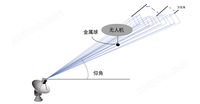Service Introduction:
The calibration of weather radar directly affects the accuracy of detection parameters, so it is crucial for the application of radar data. Simultaneously calibrate the reflectivity factors of X-band polarized radar and cloud radar using metal balls. According to the characteristics of the radar under test, a detailed calibration implementation plan needs to be developed. During the calibration process, two testing points, far and near, are selected, and three different types of standard metal balls are used. The reflectivity factor corresponding to the metal ball can reflect the directional pattern of the radar antenna as it changes with azimuth and elevation angles. Regular calibration can improve the measurement accuracy of relevant radar, timely detect possible problems with radar, and enhance the quality of operation and maintenance as well as the service life of equipment.


Service Content:
1. Drones equipped with metal balls for calibration have good maneuverability;
2. Using specially designed metal balls with minimal impact on reflectivity;
3. Multi angle observation to improve calibration accuracy;
4. Two testing points, near-field and far-field;
5. Efficient program processing without waiting;
6. Convenient on-site deployment for field operations;
7. Application areas: Radar that requires calibration in meteorology, environment, scientific research, etc.
Principle of metal ball calibration:
The scattering of electromagnetic waves by metal spheres propagates in all directions of space, and the relationship between the backscattering cross-section and wavelength is known. The normalized scattering cross section is a function of the dimensionless scattering parameter 2 π a/λ (where a is the radius of the sphere and λ is the wavelength). Select relatively open areas around the radar at a distance of about 4km as test points. In clear weather conditions with no or weak winds near the ground, use a drone carrying a precise GPS positioning device to fix the metal ball at a height of about 300-500m above the ground. By using GPS to record the position information of the metal ball and the latitude, longitude, and altitude information of the radar, the observation elevation and azimuth angles of the metal ball relative to the radar are calculated. Based on this, the calibration observation mode is set: the azimuth is centered on the azimuth angle of the metal ball, with a variation range of 60 °; On the elevation angle, set the step angle centered on the elevation angle of the metal ball to obtain multi-layer elevation angles. After obtaining radar observation data, the position information of the metal ball recorded by GPS and the latitude, longitude, and altitude information of the radar are used to calculate the observation elevation angle, azimuth angle, and number of databases of the metal ball relative to the radar. Based on this, the reflectivity factor corresponding to the standard ball in the observation data is extracted and averaged, and the theoretical value and observation value are analyzed. At the same time, radar correction is carried out according to the results.

